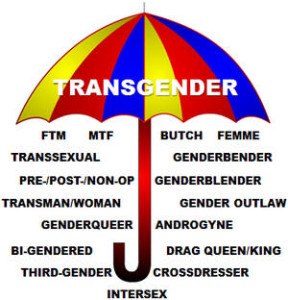Advanced Terms Related to Gender Identity and/or Gender Expression
The following terms fall under the umbrella of “Transgender”, as also defined below. In this section, we’ve incorporated some additional terms from a “Trans for Doofuses” we found that gave some quick definitions for some common terms.
Transgender: (adj) An umbrella term that can include preoperative, postoperative or nonoperative transsexuals, female and male cross-dressers, drag queens or kings, female or male impersonators and intersex individuals. If an individual prefers to be called transsexual, drag queen or king, intersex, etc., use that term.
Another definition: An umbrella term increasingly preferred by people whose appearance, personal characteristics or behaviors are gender  role nonconforming … individuals who might otherwise call themselves transsexual, cross-dressing or gender-bending. Also preferred by some people who are emotionally neither sex or both sexes or whose gender role expression is significantly different from what society expects of people of their sex or changes from time to time. Transgender people may be heterosexual or gay, lesbian, or bisexual. Some people self-identify as trans rather than transgender.
role nonconforming … individuals who might otherwise call themselves transsexual, cross-dressing or gender-bending. Also preferred by some people who are emotionally neither sex or both sexes or whose gender role expression is significantly different from what society expects of people of their sex or changes from time to time. Transgender people may be heterosexual or gay, lesbian, or bisexual. Some people self-identify as trans rather than transgender.
One more definition: This term is used to signify someone who transgresses the man/woman dichotomy and rejects the binary gender system. Transgender in this way can mean cross dressers, butch/fem, transsexual, third genders, androgynes, queergenders, genderbenders, genderblenders, and whatever other terms folks prefer.
Note: The image on the right is an image we found on the Internet. While it helps to depict many of the terms/conditions that may fall under the general “transgender” umbrella term, we recognize that some people might disagree with some of the terms included here. That debate, if any, is for another time and place. We’re just trying to get across that the term “transgender” can and does encompass many different people and conditions.
Found along with this image: According to the Trans Activist Network:
In simplest form, “trans” refers to transgender, transsexual, intersex, cross-dressing, drag, butch, femme and all other forms of gender variance. Trans individuals seek gender rights allowing them to present their gender identity as best suits them. “Trans” is not limited to individuals who change their “sex” or their bodies, but includes everyone who desires a greater freedom of gender expression.
Gender Identity: One’s understanding or feeling about whether one is emotionally or spiritually male or female or both or neither. A person may be congruent (i.e., his/her gender identity and physical gender are consistent) or transsexual (born biologically one gender; but emotionally and spiritually, the other) or not quite either one.
Gender role: One’s gender expression and one’s beliefs and feelings about the appropriate and/or comfortable expression of one’s gender. To some degree, gender role is clearly learned (socially constructed and culture-specific). To some degree, people are probably biologically predisposed to be more “feminine” or “masculine.”
Omnisexual or Pansexual: One whose romantic, emotional, or sexual attractions are geared towards others regardless of sex and/or gender expression.
Transexual (or Transssexual): (noun) An individual who identifies himself or herself as a member of the opposite sex and who acquires the physical characteristics of the opposite sex. Individual can be of any sexual orientation. To determine accurate use of names or personal pronouns, use the name and sex of the individual at the time of the action.
Another Definition: A person (pre, post or non-operative) who is biologically one sex (at birth), but emotionally and spiritually another. Female-to-male transsexual (FTM) people are born with female bodies, but identify as male. Male-to-female transsexual (MTF) people are born with male bodies, but identify as female.
FTM: Acronym for “female to male.” A transgender person who, at birth or by determination of parents or doctors, has a biological identity of female but a gender identity of male. Those who have undergone surgery are sometimes described as “post-op FTMs” (for post-operative). See gender identity and intersex.
MTF: Acronym for “male to female.” A transgender person who, at birth or by determination of parents or doctors, has a biological identity

of male but a gender identity of female. Those who have undergone surgery are sometimes described as “post-op MTFs” (for post-operative). See gender identity and intersex.
Pre-/Post-/Non-Op: This refers to the level and/or stage of physical transition an FtM or MtF transexual might go through. A pre-op person has not yet have had any surgeries to alter their body to fit their gender. A pre-op may also be not yet be on hormone therapy to change their secondary sex characteristics. A post-op person has had operations. A non-op person does not intend to surgically alter their body, but rather live in the body they have as the gender they are.
Transition: The process by which one alters one’s sex. This may include surgery, hormone therapy and changes of legal identity.
SRS: Shorthand for Sex Reassignment Surgery. I.e. gives a biological male a vagina and removes the breasts of a biological female. For FtMs, the breast-removal surgery is referred to as “top surgery” and the lower area procedure is referred to as “bottom surgery.”
Bio-Male/Bio-Female: The complex distilled into the simplistic. Basically, for those who are anatomically considered “male” this means having a penis at birth, and for those who are anatomically considered “female” this means ovaries, womb, vagina, etc. at birth. Also refers to chromosomes. The terms are used to refer to what gender roles people were assigned at birth.
Transman/Transboy: A bio-female who identifies as a man or boy. May be pre, post, or non op.
Transwoman/Transgirl: A bio-male who identifies as a woman or girl. May be pre, post, or non op.
Intersex or Intersexual: An adjective to describe a person (referred to archaically as a hermaphrodite) who was born with an anomaly of the reproductive system – with genitals or chromosomes that were not clearly male or female. At least 1 in 2,000 children is born with genitals that make it difficult for even an expert to determine their sex. Some doctors consider such anomalies as hypospadias (in which the urethral opening is somewhere other than the tip of the penis) which occur in 1 of every 200 baby boys to be intersexed conditions. For more on the intersex community, visit the Intersex Society of North American website.
Gender Binary: The social rules that state that one must be a boy or a girl, a man or a woman. It enforces the outdated and repressive concept that there are only two genders. Also includes rules of conduct, dress, and biology for the two roles.
Congruent: Having a gender and a gender identity that match. Non-transsexual and post-operative transsexual people are congruent.
Cisgender: Someone who associates and is comfortable with the gender they were assigned at birth.
Third Gender: There’s a growing number of people who reject the either/or binary gender system (i.e., “male” or “female”) and prefer to consider themselves the “and” of the gender world. You could almost say, historically speaking, that berdaches were third gendered.
Bi-Gendered: Someone who identifies as male and/or female, but in a fluid state where they go between those genders depending on the day or context (e.g.,”today I feel more male”).
Androgyne: Someone who combines the characteristics of masculine and feminine gender expressions.
Genderqueer: Someone who rejects the gender binary and feels as they are both genders or neither gender continually.
Genderbender: Someone who expresses their gender in nontraditional ways.
Genderblender: Someone who blends the characteristics of traditional gender roles. (Note: This term is not commonly used in the U.S. at present.)
Gender Outlaw: A person who defies traditional gender roles by refusing to be defined by conventional definitions of man and woman.
Butch: A term for masculine gender expression. Has nothing to do with gender, sexuality, or sex.
Femme: A term for feminine gender expression. Yet again, has nothing to do with gender, sexuality, or sex. However, as I’ve discovered, lesbian femme, bi femme, and straight femme are very different things.
Drag: Attire of the opposite sex.
Drag Performers: Entertainers who dress and act in styles typically associated with the opposite sex (drag queen for men, drag king for women). Not synonymous with transgender or cross-dressing.
Drag Queen: A man identified bio-male who takes on the role of a woman for personal or entertainment reasons.

Drag King: A woman identified bio-female who takes on the role of a man for personal or entertainment reasons.
Cross-Dresser: Preferred term for person who wears clothing most often associated with members of the opposite sex. Not necessarily connected to sexual orientation.
Transvestite: Avoid. Coined in the 19th century. A person – not necessarily gay – who dresses in clothing most often associated with another gender. The increasingly preferred term is a person who cross-dresses.
Two-Spirit People (also Two Spirit or Twospirit): An English term that emerged in 1990, out of the third annual inter-tribal Native American/First Nations gay and lesbian conference, in Winnipeg, to describe Native Americans who fulfill one of many mixed gender roles found traditionally among many Native Americans and Canadian First Nations indigenous groups. The mixed gender roles encompassed by the term historically included wearing the clothing and performing the work associated with both men and women.
A direct translation of the Ojibwe term, Niizh manidoowag, “two-spirited” or “two-spirit” is usually used to indicate a person whose body simultaneously houses a masculine spirit and a feminine spirit. The term can also be used more abstractly, to indicate presence of two contrasting human spirits (such as Warrior and Clan Mother) or two contrasting animal spirits (which, depending on the culture, might be Eagle and Coyote); however, these uses, while descriptive of some aboriginal cultural practices and beliefs, depart somewhat from the 1990 purposes of promoting the term.
According to Brian Joseph Gilly, male berdachism “was a fundamental institution among most tribal peoples.” Will Roscoe writes that male and female berdaches have been “documented in over 130 tribes, in every region of North America, among every type of native culture.”
